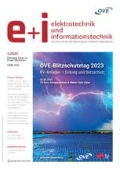Zusammenfassung
Für die Simulation von transienten lokalen Kraftanregungen innerhalb einer elektrischen Maschine wird eine Simulationsumgebung vorgestellt. Damit ist es möglich, drehzahl- und drehmomentdynamische Vorgänge zu bewerten. Es werden sowohl das Simulationsmodell als auch die Methode zur Kraftberechnung beschrieben und ein Simulationsergebnis als Abschluss gezeigt.
Abstract
A simulation environment for the transient simulation of local force excitations of electrical machines is presented. The model enables the evaluation of dynamic speed and torque situations. The simulation model as well as the method of the force determination are shown and a simulation result is given.







Literatur
Bösing, M., Niessen, M., Lange, T., De Doncker, R. (2012): Modeling spatial harmonics and switching frequencies in PM synchronous machines and their electromagnetic forces. In 2012 XXth international conference on electrical machines (ICEM) (S. 3001–3007).
Bossavit, A. (1990): Forces in magnetostatics and their computation. J. Appl. Phys., 67(9), 5812–5814.
Bossavit, A. (1992): Edge element computation of the force field in deformable bodies. IEEE Trans. Magn., 8(2), 1263–1266.
Braunisch, D., Ponick, B., Bramerdorfer, G. (2013): Combined analytical-numerical noise calculation of electrical machines considering nonsinusoidal mode shapes. IEEE Trans. Magn., 49(4), 1407–1415.
Coulomb, J. L. (1983): A methodology for the determination of global electromechanical quantities from a finite element analysis and its application to the evaluation of magnetic forces, torques and stiffness. IEEE Trans. Magn., 16(6), 2514–2519.
Dutt, A., Rokhlin, V. (1995): Fast Fourier transforms for nonequispaced data, II. Appl. Comput. Harmon. Anal., 2, 85–100.
Fischer-Hinnen, J. (1904): Über das Pfeifen von Maschinen. Z. Elektrotech., 23, 399.
Gieras, J. F., Wang, C., Cho Lai, J. (2006): Noise of polyphase electric motors. Boca Raton: CRC Press (Taylor & Francis Group).
Giet, M. v. d. (2011): Analysis of electromagnetic acoustic noise excitations: a contribution to low-noise design and to the auralization of electrical machines. Diss. IEM, RWTH Aachen University. Aachen: Shaker.
Hameyer, K., Mertens, R., Pahner, U., Belmans, R. (1998): New technique to enhance the accuracy of 2-D/3-D field quantities and forces obtained by standard finite-element solutions. IEE Proc. Sci. Meas. Technol., 145(2), 67–75.
Henrotte, F., Hameyer, K. (2007): A theory for electromagnetic force formulas in continuous media. IEEE Trans. Magn., 43(4), 1445–1448.
Jordan, H. (1950): Geräuscharme Elektromotoren. Essen: Verlag W. Girardet.
Le Besnerais, J., Lanfranchi, V., Hecquet, M., Brochet, P. (2010): Characterization and reduction of audible magnetic noise due to PWM supply in induction machines. IEEE Trans. Ind. Electron., 57(4), 1288–1295.
McFee, S., Webb, J. P., Lowther, D. (1988): A tunable volume integration formulation for force calculation in finite-element based computational magnetostatics. IEEE Trans. Magn., 24(1), 439–442.
Müller, G. (1995): Theorie elektrischer Maschinen. Weinheim: VCH.
Ren, Z., Razek, A. (1992): Local force computation in deformable bodies using edge elements. IEEE Trans. Magn., 28(2), 1212–1215.
Roivainen, J. (2009): Unit-wave response-based modeling of electromechanical noise and vibration of electrical machines. Dissertation. Helsinki: University of Technology.
Timar, L., Fazekas, A., Kiss, J., Miklos, A., Yang, G. S. (1989): Noise and vibration of electrical machines. Amsterdam: Elsevier.
Yang, J. S. (1981): Low-noise electrical motors. Oxford: Clarendon.
Author information
Authors and Affiliations
Corresponding author
Rights and permissions
About this article
Cite this article
Herold, T., Franck, D., Böhmer, S. et al. Transientes Simulationsmodell für lokale Kraftanregungen elektrischer Antriebe. Elektrotech. Inftech. 132, 46–54 (2015). https://doi.org/10.1007/s00502-014-0277-y
Received:
Accepted:
Published:
Issue Date:
DOI: https://doi.org/10.1007/s00502-014-0277-y

